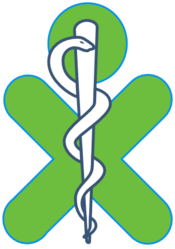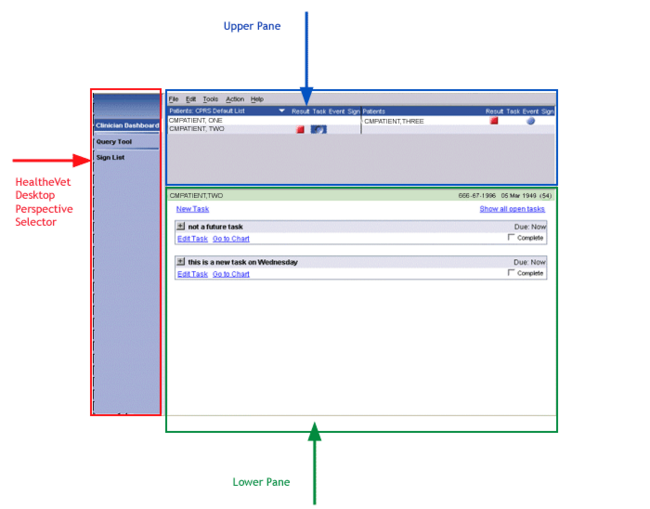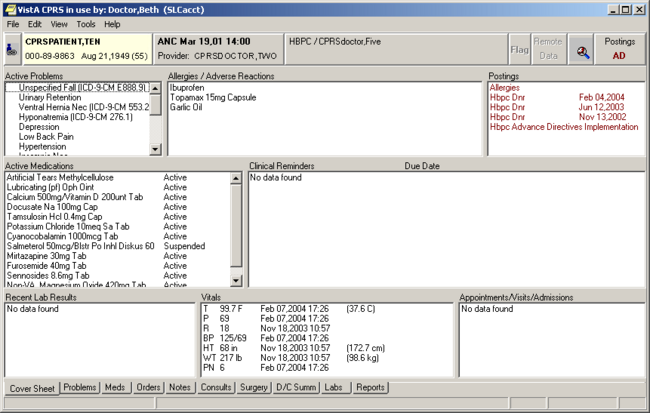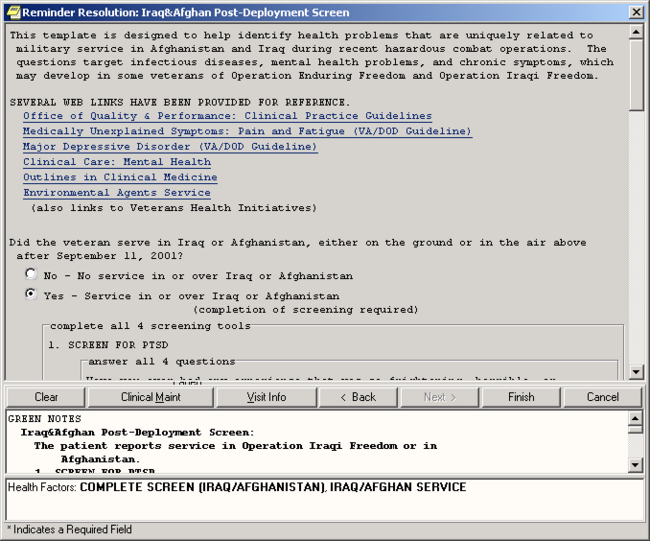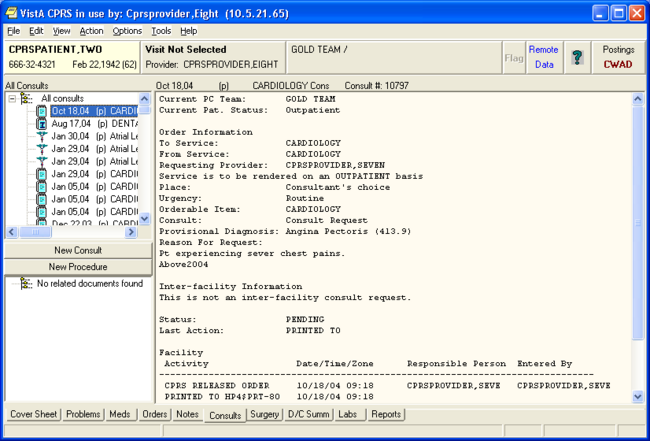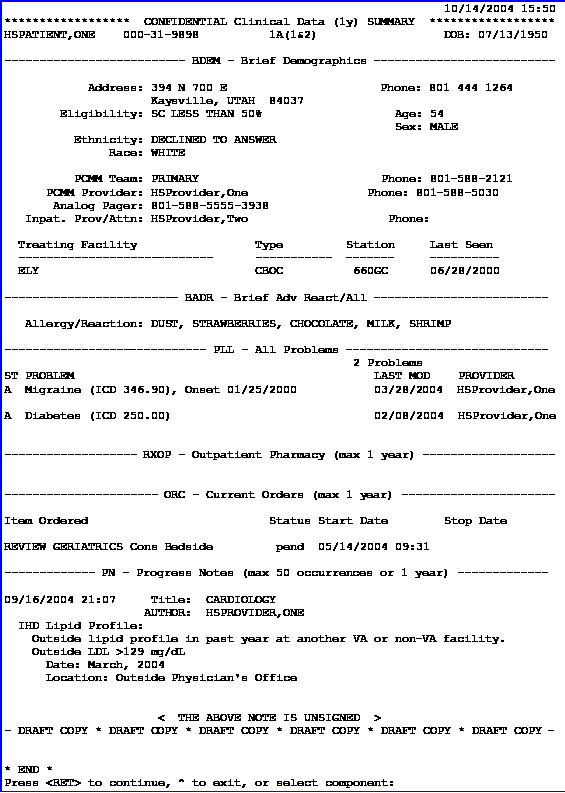WV VM
Porting VistA to the OLPC. For introduction to VistA components see VistA Monograph Wiki.
The initial copy of the was generated from the VA's Vista Monograph in MS Word format.
It is way too big and some browsers may choke on it. Need to split this into about 10 pages or so AND keep the Table of Contents intact.
We have begun the process of manually editing and bringing it up to date.
Introduction
eVet-VistA
VA'S Current and future Computerized Patient Record System
VistA-(Today)
The Department of Veterans Affairs (VA) has had automated information systems in its medical facilities since 1985, beginning with the Decentralized Hospital Computer Program information system, including extensive clinical and administrative capabilities. The Veterans Health Information Systems and Technology Architecture (VistA), supporting ambulatory and inpatient care, delivered significant enhancements to the original system with the release of the Computerized Patient Record System (CPRS) for clinicians in 1997. CPRS provides a single interface for health care providers to review and update a patient's medical record and to place orders, including medications, special procedures, x-rays, patient care nursing orders, diets, and laboratory tests. CPRS is flexible enough to be implemented in a wide variety of settings for a broad spectrum of health care workers and provides a consistent, event-driven, Windows-style interface.
CPRS organizes and presents all relevant data on a patient in a way that directly supports clinical decision-making. The comprehensive cover sheet displays timely, patient-centric information, including active problems, allergies, current medications, recent laboratory results, vital signs, hospitalization, and outpatient clinic history. This information is displayed immediately when a patient is selected and provides an accurate overview of the patient's current status before clinical interventions are ordered. CPRS capabilities include:
- A Real-Time Order Checking System that alerts clinicians during the ordering session that a possible problem could exist if the order is processed;
- A Notification System that immediately alerts clinicians about clinically significant events;
- A Patient Posting System, displayed on every CPRS screen that alerts clinicians to issues related specifically to the patient, including crisis notes, warning, adverse reactions, and advance directives;
- The Clinical Reminder System that allows caregivers to track and improve preventive health care for patients and ensure timely clinical interventions are initiated.
- Remote Data View functionality that allows clinicians to view a patient's medical history from other VA facilities to ensure the clinician has access to all clinically relevant data available at VA facilities.
VistA Imaging is also operational at most VA Medical Centers. VistA Imaging provides a multimedia, on-line patient record that integrates traditional medical chart information with medical images, including x-rays, pathology slides, video views, scanned documents, cardiology exam results, wound photos, dental images, endoscopies, etc. into the patient record.
Bar Code Medication Administration addresses the serious issue of inpatient medication errors by electronically validating and documenting medications for inpatients. It ensures that the patient receives the correct medication in the correct dose, at the correct time, and visually alerts staff when the proper parameters are not met.
HealtheVet Desktop is an application framework that will host the new generation of Veterans Health Administration (VHA) clinical applications. Care Management is the first application to run on the new HealtheVet Desktop and is an enhancement of CPRS designed to assist health care providers to follow-up on clinical interventions that might otherwise be missed. Care Management provides an automated method for tracking follow-up actions/tasks for a panel of patients for a designated period of time. The four perspecitives of Care management are the Clinician Dashboard, the Nursing Dashboard, the Query Tool and the Sign List. Implementation of the Care Management project will improve patient care by:
- Ensuring that appropriate clinical interventions are provided on a timely basis;
- Ensuring that clinical notifications are processed on a timely basis;
- Reducing the amount of time primary care providers spend reviewing individual patient records; and
- Reducing the risk of erroneous data entry
HealtheVet-VistA-(Future)
A strategy has been developed to move the Veterans Health Information Systems toward "HealtheVet", an ideal health information system to support the ideal veterans health system. Collaboratively among the Department, field, and central office leadership and the Chief Information Officer, a proposed strategy has been developed for both VA and Veterans Health Administration needs. The strategy is built around five major systems and integrates five cross-cutting issues:
- The Health Data System [health data repository (HDR)] will create a true longitudinal health care record including data from VA and non-VA sources. The health data system will support research and population analyses, facilitate patient access to data and sharing of information across VHA, and improve data quality and data security.
- Provider Systems support healthcare providers' care for veterans and feed information to VistA today and the HDR in the future. These include CPRS, VistA Imaging, Blood Bank, Pharmacy, Laboratory, Federal Health Information Exchange (FHIE), and Scheduling.
- Management/Financial Systems include four applications that are each ten or more years old and will be replaced: the Financial Management System, Billing and Accounts Receivable (AR), and Fee Basis (paying providers).
- Information and Education Systems with an emphasis on "eHealth" include prescription refills, appointments, fillable forms online, and My HealtheVet (access to health record, on-line health assessment tools; and high quality health information).
- Registration, Enrollment, and Eligibility Systems will be developed as a single, department-wide data system and demographic database that supports registration and eligibility for the three Administrations and makes this information more accessible and consistent.
- Cross-Cutting Issues include the VA and VHA architectures, information security, data quality, and leadership and management. These issues cut across all systems and ensure effective implementation and operations of the major systems.
Graphical Illustration of the HealtheVet-VistA Strategy
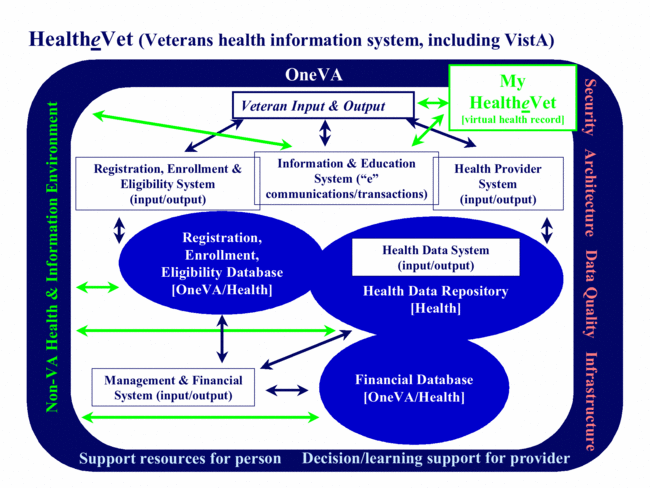
Veterans Health Information System, including VistA
Getting WorldVistA
Need to tell folks what to do with this stuff after they get it.
FOIA
The FOIA Freedom Of Information Act release is available here.
WorldVistA
Download WorldVistA Software
GT.M
And you will need GT.M
VistA Software Packages
Health Data Systems
The Health Data Repository (HDR) is the cornerstone of the Health Data Systems (HDS) portfolio. The HDR will serve as an operational clinical repository-a collection of clinical information, from VA and non-VA sources, residing on one or more independent platforms-to be used by clinicians and other personnel to facilitate longitudinal, patient-centric care. Data in the HDR will be organized in a format supporting the delivery of care regardless of the physical location of a patient's clinical information. The HDR will provide additional significant benefits including providing information to support research and population analyses, facilitating patient access to data and sharing information across VHA, improving data quality and data security, and reducing the burden on local VistA systems.
Automated Medical Information Exchange (AMIE)
Overview
The Automated Medical Information Exchange (AMIE) module facilitates the electronic interchange of veteran information between Veteran Benefits Administration (VBA) Regional Offices (ROs) and VA medical facilities. The comprehensive module provides an accurate audit trail to track most requests for information.
The module is composed of two components: Facility administrative options and VBA Regional Office options. Each area has individual items to maintain daily, and its own reports to print. RO staff access VA medical facility computers through VA national telecommunications network, and exercise their options on each local medical facility's system as necessary.
Features
- Provides access to local databases for identification of a veteran's admission, discharge, outpatient treatment, patient care, and other information that may require adjudicative actions.
- Reduces overpayments previously caused by lost, misrouted, or improperly processed admission notifications.
- Provides on-line status determinations of pending compensation and pension examinations (requesting, scheduling, tracking, and updating results).
- Provides RO on-line access to the local databases for the confirmation of the propriety of payments based on hospitalization.
- Improves timeliness of the RO benefits adjustment processing.
- Allows medical centers to electronically access sections of the Physicians Guide for Disability Evaluation Examinations.
- Provides tracking of insufficiently completed compensation and pension examinations.
Incident Reporting
Overview
The Incident Reporting module supports VHA policy by compiling data on patient incidents. It organizes the data into defined categories for reporting and tracking at medical facility level and for transmission to the National Quality Assurance Database for Headquarters review and tracking.
Features
- Provides options to simplify the setup of the software.
- Allows for the entry of all required incident information plus descriptive data and actions taken on all reportable and/or locally defined incidents.
- Prints out a Pseudo 10-2633 Incident Worksheet.
- Provides an ad hoc reporting mechanism that uses VA FileMan modifiers for sorting or printing the following data fields:
Patient Type of Death
Patient ID Level of Review
Date of Admission Date of Incident
Patient Type Incident Case Status
Ward/Clinic Severity Level
Treating Specialty Fall Assessment Score
Service Person Reporting the Incident
Responsible Service Patient Diagnosis
Medication Errors Medical Center Action
Case Number Incident Description
Incident Pertinent Information
Incident Location National Case Status
WV Lexicon Utility WV Occurrence Screen WV Patient Representative WV Registration Enrollment and Eligibility Systems WV Clinical Monitoring System WV Enrollment Application System EAS WV Hospital Inquiry HINQ WV Income Verification Match IVM WV Record Tracking WV Veteran Identification Card VIC
Health Provider Systems
Health Provider Systems are information systems supporting health care providers in the care of veterans by feeding information to main systems such as VistA today and the Health Data Repository (HDR) in the future. Key HPS systems include:
- VistA Imaging
- Blood Bank
- Pharmacy
- Laboratory Services
Care Management
Overview
Care Management is the first application to run within the HealtheVet Desktop (the VHA's new Java application framework) and the first to offer a convenient way for healthcare providers to view on a single screen pertinent information about multiple patients. With Care Management, users can see at a glance multiple patients for whom they have items that require attention. The current distribution of Care Management offers the following four perspectives (which are similar to applications):
- Clinician Dashboard-Provides an easy-to-read table of patients for whom clinicians have unacknowledged results or event notifications (such as hospital admissions, discharges, or unscheduled clinic visits), unsigned documents, or uncompleted tasks.
- Nurse Dashboard-Provides an easy-to-read table of patients for whom nurses have unacknowledged results, unviewed events, uncompleted tasks or text orders, unverified orders, or recent vitals.
- Query Tool-Enables authorized users to create reports based on the most current patient data available. The Query Tool offers five pre-defined reports and also enables users to create their own customized reports.
- Sign List-Enables users to sign multiple items for multiple patients. For example, using the Sign List, a clinician can sign a discharge summary for John Smith and notes for Jane Smith simultaneously.
This distribution of Care Management also includes the Task Editor, which enables users to create patient-related tasks.
Features
Care Management comprises an extensive set of features designed to simplify and improve patient care.
These features include (but are not limited to) the following:
- Colored-coded icons that indicate the priority status of dashboard items
- A default patient list that is based on users' Computerized Patient Record System (CPRS) default patient list
- A dynamically generated, user-based patient list
- Custom patient lists
- Checkboxes for acknowledging and verifying individual or multiple dashboard items
- The ability to set date ranges for dashboard items
- The ability to link tasks to other tasks or to events
- The ability to prioritize, edit, and delete tasks
- Text boxes that expand to provide detailed information about dashboard items
- A variety of predefined reports, including the following:
- Abnormal Results
- Consult Status
- Incomplete Orders
- Recent Activity
- Scheduled/Due Activity
- Custom reports with a wide selection of criteria, including (but not limited to) the following:
- Screen by Inpatient, Outpatient, or Pharmacy Visits
- Screen by Primary Outpatient Provider
- Orders/Results
- Consults/Procedures
- The ability to print and export reports
Care Management is tightly integrated with CPRS. As a result, from within Care Management, users can:
- Go directly to a patient's chart in CPRS
- Clear selected result notifications in CPRS, including notifications in the following categories:
- Events
- Results
- Actions
Care Management's intuitive Graphical User Interface (GUI) includes an extensive selection of clickable items from which users can:
- Select a default perspective
- Select dashboard preferences
- View demographic information for individual patients
- View details about specific action items
- And much more
Care Management Clinician Dashboard running in the HealtheVet desktop.
| header 1 | header 2 | header 3 |
|---|---|---|
| row 1, cell 1 | row 1, cell 2 | row 1, cell 3 |
| row 2, cell 1 | row 2, cell 2 | ro
</blockquot
|
Computerized Patient Record System (CPRS)
Status
![]() Check
Check
![]() Alt CPRS Alternative OpenVista CIS
Alt CPRS Alternative OpenVista CIS
Porting to OLPC XO
There are several options for Porting Clients to the XO
Overview
CPRS enables clinicians to enter, review, and continuously update all order-related information connected with any patient. With CPRS, you can order lab tests, medications, diets, radiology tests and procedures, record a patient's allergies or adverse reactions to medications, request and track consults, and enter progress notes, diagnoses, and treatments for each encounter, and enter discharge summaries. Close integration with the Clinical Reminders and Text Integration packages allows better record keeping and compliance with Clinical Guidelines and medical record requirements.
CPRS not only allows hospital personnel to keep comprehensive patient records, it also enables clinicians, managers, and QA staff to review and analyze the data gathered on any patient in a way that directly supports clinical decision-making..
CPRS Cover Sheet Example
CPRS: Adverse Reaction Tracking
Overview
The Adverse Reaction Tracking (ART) program provides a common and consistent data structure for adverse reaction data. This module has options for data entry and validation, supported references for use by external software modules, and the ability to report adverse drug reaction data to the Food and Drug Administration (FDA).
Features
- Documents patient allergy and adverse drug reaction data.
- Provides the functionality for other VistA modules to extract and add patient reaction data.
- Provides a reporting mechanism that supports VHA Directive 10-92-070 which specifies reporting of adverse drug reactions to the FDA.
- Includes ART event points in an Application Programmers Interface (API) allowing other VistA packages to know when specific ART events take place so package tasks can be performed.
- Alerts the Pharmacy and Therapeutics Committee each time the signs/symptoms are modified for a patient reaction.
- Generates progress notes. Displays all information at the time of an ART event on the Progress Notes API and allows editing of the note prior to sign off.
- Allows the site to track whether the patient has been asked if he/she has allergies.
- Tracks when the patient chart and ID bands have been marked indicating a particular reaction.
- Differentiates between historical and observed reactions.
- Tracks the particular signs/symptoms for a reaction.
- Allows for configuration of allergy files.
- Allows for editing and verification of reaction data.
- Allows for the addition of comments for each reaction to ensure completeness in reporting.
- Contains extensive reporting capabilities.
- Contains an online reference guide.
CPRS: Authorization/Subscription Utility (ASU)
Overview
The Authorization/Subscription Utility (ASU) provides a method for identifying who is authorized to perform various actions on clinical documents. These actions include signing, co-signing, and amending. ASU originated in response to Text Integration Utilities' document definition needs. Current security key capabilities were unable to efficiently manage the needs of clinical documentation (Discharge Summaries, Progress Notes, etc.).
Features
- Defines, populates, and retrieves information about user classes. User classes can be defined hospital-wide or more narrowly for a specific service and can be used across VistA to replace and/or complement keys.
- Links user classes with Text Integrated Utilities (TIU) document definitions and document events.
- Allows sites to maintain membership of users in User Classes and to distribute such maintenance tasks.
- Lists class members as active or inactive.
- Allows infinite hierarchies of subclasses.
- Defines business rules to further manage document activities.
CPRS: Clinical Reminders
Overview
The Clinical Reminders package is a valuable aid in patient treatment. Reminders assist clinical decision-making and educate providers about appropriate care. Electronic clinical reminders also improve documentation and follow-up, by allowing providers to easily view when certain tests or evaluations were performed and to track and document when care has been delivered. They can direct providers to perform certain tests or other evaluations that will enhance the quality of care for specific conditions.
Clinical Reminders may be used for both clinical and administrative purposes. However, the primary goal is to provide relevant information to providers at the point of care, for improving care for veterans. The package benefits clinicians by providing pertinent data for clinical decision-making, reducing duplicate documenting activities, assisting in targeting patients with particular diagnoses and procedures or site-defined criteria, and assisting in compliance with VHA performance measures and with Health Promotion and Disease Prevention guidelines.
The Quality Enhancement Research Initiative (QUERI), a Health Services Research and Development (HSR&D) program, and the National Clinical Practice Guidelines Committee have joined with the Office of Information, System Design & Development office (SD&D) in designing national reminders and dialogs that will help promote informed decision-making and consistency of health care practices. Cooperatively developed reminders include: Ischemic Heart Disease (IHD), Major Mood Disorder (MDD), Hypertension, Iraq and Afghan Post-Deployment Screen, Race and Ethnicity, Women's Veterans Health, My HealtheVet, and VA Geriatric Care Referral (GEC) reminders.
Version 2 of Clinical Reminders contains many enhancements to improve processing and management of reminders. Performance has been enhanced through the creation of an index of all clinical data used in reminder findings. All enhancements are intended to help the Reminders functionality smoothly transition to CPRS Reengineering.
Features
- Allows results that are unique for each patient, by basing reminder evaluation on the patient's clinical data.
- Allows clinicians to resolve reminders through dialogs within the CPRS GUI. Using point-and-click techniques, a clinician can generate text for progress notes, update current and historical encounter data in Patient Care Encounter (PCE), update vital signs, update mental health test results/scores, and place orders.
- Allows facilities to copy, create, and customize their own reminder definitions, based on local needs.
- Provides components that can be displayed on Health Summaries.
- Provides reminders reports for summary or detailed level information about patients' reminders that are due. Reports allow providers to verify diagnoses, verify that appropriate treatment was given, identify patients requiring intervention, and validate effectiveness of care. Combined reports for multiple facilities or multiple locations can now be generated.
- Provides an enhanced Exchange Utility that allows exchange of reminder definitions and dialogs among sites and Veterans Integrated Service Networks (VISNs).
Clinical Reminders Example: Reminders Resolution Dialog
CPRS: Consult/Request Tracking
Overview
The Consult/Request Tracking package provides an efficient way for clinicians to order consultations and procedures from other providers or services within the hospital system, at their own facility or another facility. It also provides a framework for tracking consults and reporting the results. It uses a patient's computerized patient record to store information about consult requests.
Features
- Allows direct access to Consults functions through menu options in CPRS.
- Uses Consults' own menu options for managing the system, generating reports, tracking consults, or entering results for an existing consult request.
- Allows staff to set up consults as CPRS Quick Orders, streamlining the ordering process.
- Integrates with Prosthetics to track Home Oxygen, Eyeglasses, Contact Lenses, and other Prosthetics services.
- Produces a permanent record of the request and resolution for the patient's medical record.
- Allows all relevant parties to see the consult report in the context of the patient's record.
- Allows use of TIU templates and boilerplate to report findings.
- Allows display of Consult reports through TIU and CPRS.
- Enables clinicians to order a consult at another facility, using HL7 Messaging and the VA Intranet.
CPRS: Consult/Request Tracking - continued
Consults Example
CPRS: Health Summary
Overview
A Health Summary is a clinically oriented, structured report that extracts many kinds of data from VistA and displays it in a standard format. Health summaries can be printed or displayed for individual patients or for groups of patients. The data displayed covers a wide range of health-related information such as demographic data, allergies, current active medical problems, and laboratory results.
Features
- Integrates data from the following packages:
Adverse Reaction Tracking Nursing (Vital Signs)
Automated Medical Information Outpatient Pharmacy
Exchange (AMIE) Patient Care Encounter (PCE)
Clinical Reminders Problem List
Computerized Patient Record Progress Notes
System (CPRS) Radiology
Consults/Request Tracking Registration
Dietetics Scheduling
Discharge Summary Social Work
Inpatient Medications Spinal Cord Dysfunction
Laboratory System Surgery
Medicine VistA Imaging
Mental Health
- Health Summary users can print an Outpatient Pharmacy Action Profile with bar codes in tandem with a health summary.
- Health Summary now exports components that allow staff to view remote patient data through CPRS. Additionally, remote clinical data can be viewed using any Health Summary Type that has an identically named Health Summary Type installed at both the local and remote sites.
- Clinical Reminders work with Health Summary to furnish providers with timely information about their patients' health maintenance schedules. Providers can work with local coordinators to set up customized schedules based on local and national guidelines for patient education, immunizations, and other procedures.
- Health Summary components 'Progress Notes' and 'Selected Progress Notes' can display the new interdisciplinary progress notes and all of the entries associated with the interdisciplinary note.
Health Summary Example
CPRS: Problem List
Overview
Problem List is used to document and track a patient's problems. It provides the clinician with a current and historical view of the patient's health care problems across clinical specialties and allows each identified problem to be traceable through the VistA system in terms of treatment, test results, and outcome.
This application supports primary care givers, such as physicians, nurses, social workers, and others, in inpatient and outpatient settings. It is also designed to be used by medical and coding clerks. A variety of different data entry methods are possible with this application.
Use of Problem List varies from site to site, depending on the data entry method a facility has chosen. Many sites use Encounter Forms, with clerks entering most of the data in the encounter forms. Encounter forms are generated from patient data in the system and added to or modified by clinicians.
Features
- Allows a clinician to view an individual problem list for any given patient.
- Supports a variety of specialized views of a patient's problem list.
- Uses the Lexicon utility that permits the use of "natural" terminology when selecting a problem. Each term is well defined and understandable. A user, site, or application may substitute a preferred synonym.
- Can be linked to other sections of the medical record, such as Health Summary, Progress Notes, Order Entry/Results Reporting, Consults, test results, care plans for Nursing and Mental Health, Discharge Summaries, and Billing/Encounter Forms.
- Supports import of problem information from other clinical settings outside the immediate medical facility.
- Allows reformulation of a problem.
- Supports multiple forms of data capture: direct clinician entries, clerk entry, encounter forms, foreign problem lists, scanned encounter forms, hand-held devices, etc.
- Requires minimal data entry.
CPRS: Text Integration Utilities (TIU)
Overview
Text Integration Utilities (TIU) simplifies the use and management of clinical documents for both clinical and administrative medical facility personnel. In connection with Authorization/Subscription Utility (ASU), a facility can set up policies and practices for determining who is responsible or has the privilege for performing various actions on required documents.
The Version 1.0 release included Discharge Summary and Progress Notes. With the release of
CPRS and Consults/Request Tracking, TIU has been upgraded to integrate with these packages.
Features
- Provides boilerplate functionality for the automatic fill-in of information from VistA files into TIU documents. Boilerplates and embedded objects can be set up for specific types of documents for specific clinical needs.
- Interfaces with the Computerized Patient Record System (CPRS): the template utilities in the GUI version of CPRS allow speedy point-and-click composition of notes, consults, and summaries. Templates can be set up for specific types of documents for specific clinical needs. Interfaces with Problem List, Automated Information Capture System (AICS), Patient Care Encounter (PCE), Authorization/Subscription Utility (ASU), Incomplete Record Tracking, Health Summary, and Visit Tracking. Uses a standardized and common user interface, which allows clinicians and others to retrieve many kinds of documents from a single source.
- Enables healthcare practitioners to enter interdisciplinary notes regarding a single episode of care for a patient. This is accomplished through the addition of a level to the tree structure where a note can have children (subordinate entries) and each of the children can have a different author. This provides for more complete patient records and facilitates input from a variety of practitioners regarding a single episode of care.
- Interfaces with VistA Imaging allowing clinicians to link TIU documents to all types of clinical images such as X-rays, MRIs, and CAT scans.
- Uses an integrated database, which lets clinicians, quality management staff, researchers, and management search for and retrieve clinical documents more efficiently because documents reside in a single location within the database.
- Permits document input from a variety of data capture methodologies such as transcription, direct entry through CPRS or the TIU package, or upload of ASCII formatted documents into VistA.
- Uses a uniform file structure for storage of documents and management of document types.
- Uses a consistent file structure for defining elements and parameters of a document.
- Allows a variety of user actions, such as entry, edit, electronic signature, addenda, browse, notifications, etc.
- Allows a variety of management functions, including amendment, deletion, and identification of signature surrogate, re-assignment, and administrative authentication.
- Follows HL7 interface and other communication standards.
WV Dentistry WV Hepatitis C Case Registry WV Home Based Primary Care HBPC WV Immunology Case Registry ICR WV Intake and Output WV Laboratory WV Medicine WV Nursing WV Nutrition and Food Service N&FS WV Oncology WV Pharmacy Automatic Replenishment.Ward Stock AR.WS WV Primary Care Management Module PCMM WV Prosthetics WV Quality Audiology And Speech Analysis And Reporting QUASAR WV Radiology.Nuclear Medicine WV Remote Order Entry System ROES WV Scheduling WV Social Work WV Surgery WV VistA Imaging System WV Visual Impairment Service Team VIST WV Vitals.Measurements WV Women's Health WV Management and Financial Systems WV Automated Information Collection System AICS WV Beneficiary Travel WV Compensation and Pension Records Interchange CAPRI WV Current Procedural Terminology CPT WV Decision Support System DSS Extracts WV Diagnostic Related Group DRG Grouper WV Engineering WV Equipment.Turn-In Request WV Event Capture WV Fee Basis WV Generic Code Sheet WV Incomplete Records Tracking IRT WV Integrated Funds Distribution Control Point Activity Accounting and Procurement IFCAP WV Integrated Patient Funds WV Integrated Billing IB WV Patient Care Encounter PCE WV Personnel and Accounting Integrated Data PAID WV Voluntary Service System VSS WV Information and Education Systems WV Library WV Police and Security WV Cross-Cutting Monographs WV Kernel WV List Manager WV MailMan WV Master Patient Index MPI and Master Patient Index.Patient Demographics MPI.PD WV My HealtheVet WV Network Health Exchange NHE WV Patient Data Exchange PDX WV Remote Procedure Call RPC Broker WV VA FileMan WV VistALink WV VistA Development History WV Other Resources WV Acronyms
